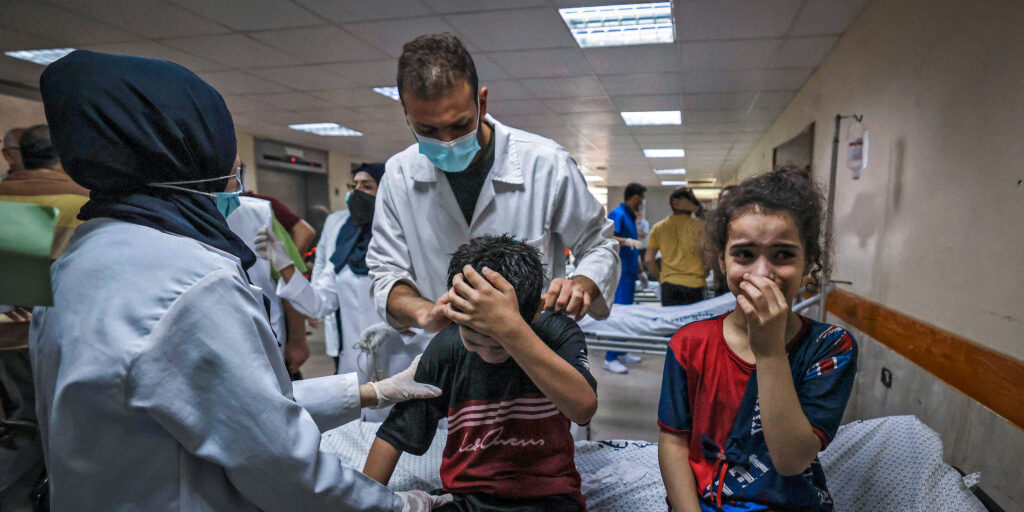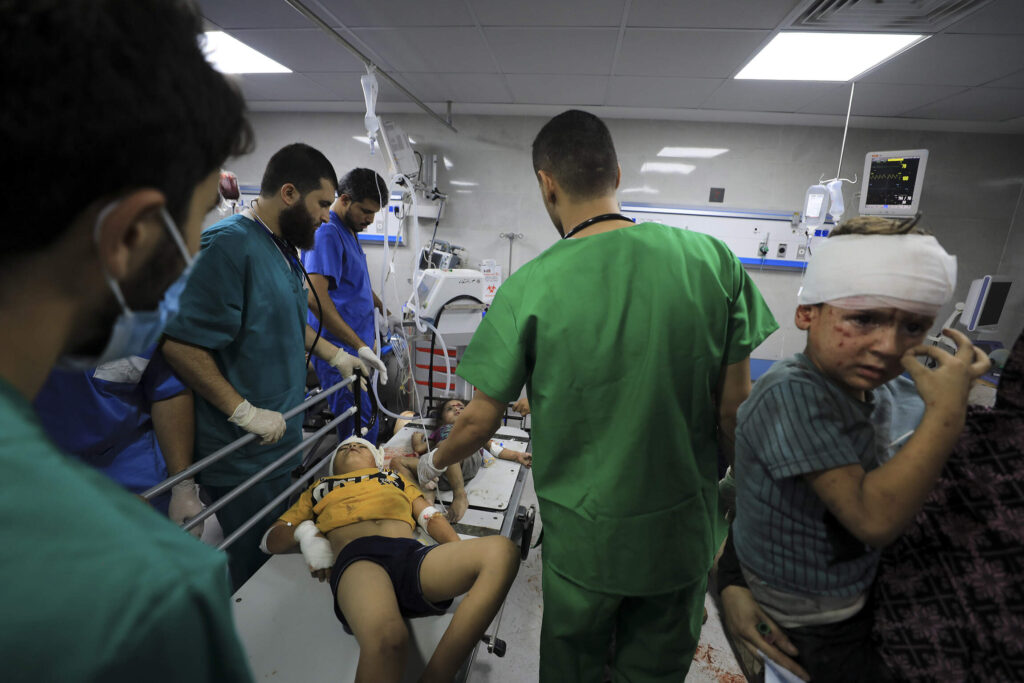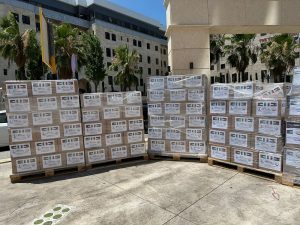Gaza, 22 ottobre 2024 – L’esercito israeliano sta attualmente assediando e prendendo di mira i tre principali ospedali del Governatorato di Gaza Nord – l’Ospedale Al-Awda, l’Ospedale Kamal Adwan e l’Ospedale Indonesiano – ordinando a tutti coloro che si trovano all’interno di lasciare le strutture. Il personale medico, i pazienti feriti e malati, compresi bambini e neonati, le donne in travaglio e i loro accompagnatori, sono intrappolati all’interno.
L’intero Governatorato di Gaza Nord è sottoposto a rinnovati ordini di sfollamento israeliani dal 7 ottobre 2024, quando Israele scatenò una nuova ondata di violenza genocida contro i palestinesi nel nord di Gaza. In uno sforzo calcolato per forzare lo sfollamento di massa dei circa 400.000 palestinesi rimasti nel nord di Gaza, Israele ha anche rafforzato ulteriormente il suo assedio sull’area, affamando la popolazione e impedendo alle forniture mediche di raggiungere gli ospedali. Nelle strade di Jabaliya e Beit Lahiya ci sono dozzine di cadaveri e feriti, molti dei quali non possono essere soccorsi o trasportati negli ospedali per ricevere cure mediche urgenti e salvavita.
Le seguenti informazioni sono state raccolte da Al Mezan sulla base di resoconti di prima mano e informazioni disponibili e sono valide al 22 ottobre 2024. La situazione si sta rapidamente deteriorando e, a meno che la comunità internazionale non agisca immediatamente per fermare il genocidio di Israele a Gaza, lo faremo. presto riferiremo del collasso totale di queste strutture mediche.
Ospedale Al-Awda, campo profughi di Jabaliya
L’ospedale Al-Awda, situato nell’area Tal al-Zatar del campo profughi di Jabaliya, è attualmente sotto assedio israeliano. L’ospedale è stato attaccato direttamente dalle forze israeliane il 19 ottobre 2024, quando diversi proiettili di artiglieria hanno colpito il secondo e il terzo piano dell’edificio orientale, danneggiando la rete Internet, parti del sistema di energia solare, i serbatoi dell’acqua e le tubature sul tetto. Questi due piani, che un tempo venivano utilizzati come alloggi per il personale, sono ora fuori servizio a causa del rischio continuo di ulteriori attacchi.
La mattina del 22 ottobre 2024, il dottor Bakr Abu Safiya, capo del dipartimento di chirurgia dell’ospedale Al-Awda, ha detto ad Al Mezan: “Non possiamo lasciare gli edifici dell’ospedale, che comprendono due edifici operativi, ciascuno alto cinque piani. insieme ad un edificio in costruzione. Nessuno, nemmeno le persone ferite, i pazienti o il personale, possono accedere all’ospedale”. Il personale medico ancora presente negli ospedali comprende quattro ostetrici e ginecologi, un chirurgo, due medici d’urgenza, due anestesisti e un numero ridotto di infermieri, che continuano a fornire cure critiche ai bisognosi. Attualmente, l’ospedale Al-Awda sta curando 35 feriti e prendendosi cura di nove donne in travaglio.
Il dottor Bakr Abu Safiya ha aggiunto: “Al momento siamo assediati, con energia in diminuzione, senza carburante per il generatore e forniture mediche estremamente basse, appena sufficienti per soddisfare anche i bisogni più elementari. La situazione è estremamente pericolosa, con l’artiglieria pesante e i bombardamenti aerei su Tal al-Zatar e la presenza quasi costante di droni di sorveglianza israeliani, comunemente noti come quadricotteri, che volteggiano sopra l’ospedale”.
Ospedale indonesiano, Beit Lahiya
L’ospedale indonesiano è attualmente sotto assedio israeliano, con 15 membri del personale medico al suo interno che lavorano per curare 30 feriti, di cui due in condizioni critiche. Due pazienti in terapia intensiva sono già morti a causa delle interruzioni di corrente e della mancanza di ossigeno derivanti dall’assedio israeliano.
La mattina del 22 ottobre 2024, il dottor Marwan Al-Sultan, direttore dell’ospedale, ha detto ad Al Mezan: “Il 19 ottobre 2024, l’esercito israeliano ha bombardato il secondo e il terzo piano dell’ospedale, con schegge sparse in tutto l’ospedale e danneggiando Ieri hanno appiccato il fuoco ad una scuola vicina e c’era il serio rischio che le fiamme raggiungessero i nostri generatori e il serbatoio solare, che sono molto vicini all’edificio. Per fortuna, l’incendio si è spento senza intervento. avremmo dovuto affrontare un grande incendio e potenziali esplosioni”.
Il dottor Al-Sultan ha aggiunto: “Siamo a corto di carburante e non abbiamo acceso i generatori negli ultimi tre giorni. L’ultima consegna di carburante è avvenuta quasi una settimana fa. Il Comitato Internazionale della Croce Rossa (CICR) ha cercato di contattarci già da ieri, ma sia ieri che oggi gli è stato negato l’accesso. Cibo e acqua stanno scarseggiando pericolosamente. I miei colleghi hanno trovato un vecchio sacco di farina conservato in ospedale, che usavano per cuocere il pane. Non c’è nient’altro disponibile. Prima dell’assedio del nord di Gaza, portavamo quotidianamente scorte di cibo, ma ora siamo a corto di tutto”.
Il dottor Al-Sultan ha anche confermato ad Al Mezan che il 21 ottobre 2024 l’esercito israeliano si è avvicinato all’ospedale indonesiano e ha convocato il dottor Iyad Dakka, chiedendo informazioni dettagliate sulla struttura. Hanno chiesto specificamente cosa è immagazzinato nel seminterrato, al primo e al secondo piano e dove si trovano i pazienti. Dopo aver ricevuto queste informazioni, un soldato israeliano ha incaricato il dottor Dakka di aprire tutte le porte del piano terra e di fotografare tutto, avvertendolo che sarebbe tornato. Il soldato ha inoltre dichiarato l’ospedale zona di combattimento, ordinando a tutti di evacuare.
Questa mattina presto, i droni quadricotteri israeliani hanno lanciato volantini a Beit Lahiya dicendo:“A tutti coloro che sono presenti nei rifugi e negli ospedali: siete in una zona di combattimento pericolosa. Per la tua sicurezza, dirigiti immediatamente verso l’ospedale indonesiano attraverso le strade Al-Awda e Beit Lahiya. Qualsiasi movimento in un’altra direzione potrebbe mettere in pericolo la tua vita!”
Ospedale Kamal Adwan, Beit Lahiya
L’ospedale Kamal Adwan, l’unico ospedale con un’unità pediatrica nel nord di Gaza, è sotto assedio dall’inizio di questo mese ed è stato sottoposto a molteplici attacchi israeliani. Ad esempio, intorno alle 9:30 del 19 ottobre 2024, gli aerei da guerra israeliani bombardarono il cortile dell’ospedale. Intorno all’1:00 del giorno successivo, 20 ottobre 2024, gli aerei da guerra israeliani bombardarono l’area circostante l’ospedale e spararono contro i serbatoi dell’acqua e la rete elettrica dell’ospedale.
Il 21 ottobre 2024, il dottor Hossam Abu Safiya, direttore dell’ospedale, ha dichiarato ad Al Mezan: “La situazione è catastrofica, senza risorse disponibili, forniture mediche o materiali di consumo. Siamo sotto assedio totale, l’ingresso di carburante, cibo e medicine è bloccato. L’esercito israeliano ha impedito all’Organizzazione Mondiale della Sanità (OMS) di consegnare forniture mediche essenziali, sebbene sia stato loro consentito di evacuare alcuni pazienti. Siamo di fronte ad un vero e proprio disastro umanitario”.
Stamattina, il dottor Hossam Abu Safiya ha confermato che le forze israeliane stanno circondando l’ospedale Kamal Adwan da tutte le direzioni, ordinando a tutti di lasciare i locali dell’ospedale e le aree residenziali circostanti utilizzando quadricotteri. Attualmente ci sono più di 150 pazienti, compresi bambini in ventilazione e neonati in incubatrici, che non possono essere evacuati. In seguito alla morte di due pazienti, il dottor Hossam Abu Saifya ha affermato che l’ospedale è stato costretto ad attuare un sistema di trattamento prioritario. Molti bambini che necessitano di ventilatori vengono lasciati senza accesso alle attrezzature salvavita.
Un ufficiale dell’ambulanza della Protezione civile ha dichiarato: “Il personale medico [all’ospedale Kamal Adwan] è limitato e il numero di feriti di Jabaliya e Beit Lahiya supera di gran lunga la capacità dell’ospedale. Chiunque sia ferito nel nord viene lasciato dissanguare. Come agenti delle ambulanze, non sappiamo dove portare i feriti. L’ospedale Kamal Adwan può ospitare solo un numero limitato di pazienti, ma nel nord di Gaza, ogni minuto, ogni secondo, le persone vengono uccise o ferite. Le persone non possono accedere ai cimiteri per seppellire i propri cari e ora sono costrette a seppellirli per strada. La situazione è catastrofica. I nostri movimenti come equipaggi della protezione civile e delle ambulanze sono severamente limitati, poiché le forze israeliane ci sparano mentre cerchiamo di evacuare i feriti”.
Conclusioni
L’escalation di attacchi contro tre degli ultimi ospedali funzionanti nei governatorati settentrionali fa parte della campagna sistematica e calcolata di Israele volta a smantellare il sistema sanitario di Gaza. Solo poche settimane fa, la Commissione d’inchiesta delle Nazioni Unite sui territori palestinesi occupati, compresa Gerusalemme Est, e Israele ha scoperto che “Israele ha attuato una politica concertata per distruggere il sistema sanitario di Gaza”.
Al Mezan sostiene che lo smantellamento sistematico e calcolato del sistema sanitario di Gaza è una componente fondamentale del genocidio israeliano contro il popolo palestinese di Gaza, volto a distruggere le istituzioni progettate per salvare vite umane e sostenere la salute pubblica e a distruggere fisicamente la popolazione palestinese di Gaza, in in tutto o in parte attraverso la privazione dell’assistenza sanitaria.
A meno che la comunità internazionale non intraprenda azioni concrete per porre fine al genocidio di Israele contro i palestinesi a Gaza, presto racconteremo il collasso totale dei tre ospedali, la morte di dozzine di pazienti in terapia intensiva, compresi bambini, e il rapimento di medici personale e sfollati interni rifugiati in questi ospedali, che saranno prelevati da Gaza e detenuti nei campi di tortura israeliani.




Lascia un commento